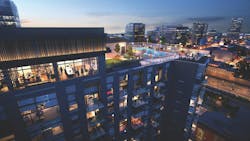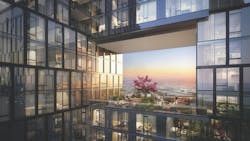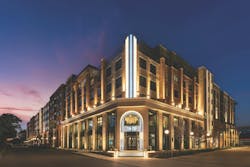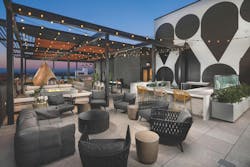Project financing tempers robust demand for multifamily housing
By John Caulfield, Senior Editor
AEC Giants with multifamily practices report that the sector has been struggling over the past year, despite the high demand for housing, especially affordable products.
“The lending and interest rate climate has essentially put the industry on hold,” says Walter Hughes, Chief Innovation Officer for Humphreys & Partners, who was interviewed in June. “It has made it increasingly difficult to pencil deals.”
WSP is still seeing “healthy” requests for new multifamily projects. But financing issues due to higher interest rates and the increased costs of construction are causing about 30% of those requests to stall after early design phases, says Brian Carroll, PE, LEED AP, the firm’s Senior Vice President and Mid-Atlantic District Business Line Lead–Property and Buildings.
Molly McShane, CEO with The McShane Companies, notes that while new deals are being planned, “projects are taking longer to close” as debt and equity providers are being more selective. “Some developers seem to be waiting to see what happens next,” confirms Ola Johansson, PE, Senior Principal with Thornton Tomasetti.
The anecdotal travails of these firms reflect national trends. The Census’s Bureau’s preliminary estimates for May housing starts, which showed a nearly 52% decline for new buildings with five or more units from the same month in 2023, were in line with Yardi Matrix’s latest U.S. outlook that forecast record multifamily deliveries in 2024 but also a slowdown in starts due to high interest rates and a tightening of credit by commercial banks.
Market conditions find AEC firms looking wishfully at multifamily’s future. “A rebound is expected, but slower than previously anticipated,” observes Meaghan McGee, PE, LEED AP, Senior Associate with the engineering firm Kimley-Horn. “Some development groups have held the term ‘Survive till ’25.’ That mantra is now ‘Survive through ’25.’”
Pockets of activity for the multifamily construction market
As the industry readjusts to the market’s current financial realities, AEC firms are taking comfort in serving pockets of building activity. For example, Johansson says there’s still demand for multifamily projects in Miami, especially for “very high-end product.”
“We’re seeing pushes on two fronts: for a robust luxury rental product, and for a more ambitious inclusionary/affordable rental product,” says Rebecca Gromet, a Principal with Kohn Pedersen Fox. She elaborates that the demand for luxury is coming primarily from smaller developers, while affordable demand is coming specifically from metros like the New York City market. “These are often some component of a mixed-use development to balance the economics, but we are [also] seeing higher aspirations in terms of design.”
Stantec has been uncovering multifamily opportunities outside of urban cores, and in affordable housing projects that are supported by state and federal government investment and tax credits. “We currently have several hundred affordable homes in design, and approximately 250 [units] in construction,” says James Gray, a Senior Principal in Stantec’s Boston office.
California-based design firm AO is witnessing “significant growth” in its affordable housing sector, and has a substantial pipeline of modular communities coming online. “This diversification allows us to address various market needs,” says Ioanna Magiati, NCARB, a Partner and Architect with AO.
Most multifamily projects are new construction, and renovations are mostly office-to-residential conversions, say AEC sources. “Our clients need support navigating entitlements, permitting, and accessibility requirements,” says McGee of Kimley-Horn.
Other firms are tapping into multifamily as an element of adaptive reuse. One of Humphreys & Partners’ recent projects is Tin Top Flats at The Creamery, a 338-unit luxury multifamily development in San Antonio that is integrated into the revitalization of the historic Borden Dairy plant. The design challenge of this project was in creating an exterior envelope that would blend into the building’s 1930 Art Deco look.
Ground-floor retail has become a standard amenity in multifamily projects. Mixed-use in general, though, “often depends on the market and location,” explains Marc Padgett, President of Summit Contracting Group. A multifamily project in a downtown urban area is “very likely” to be mixed use, whereas a three- or four-story garden apartment building in the suburbs would most likely be residential-only.
Retail and office are the most common mixed-use components that are part of Balfour Beatty’s multifamily work across the country, says Roy Evans, Operations Director of the firm’s North Texas Region. In that market, Balfour Beatty is also delivering projects that include a hospitality component. One prominent example is the million-sf Knox Street development on four acres in Dallas. The complex, which is expected to open in 2026, includes a 27-story, 173-unit multifamily tower, 150,000 sf of office space, 100,000-plus-sf of retail and restaurant space, and the Knox Hotel and Residences with 140 hotel rooms and 48 condos.
(Balfour Beatty is building this under a joint venture with ANDRES Construction.)
AO, says Magiati, is also designing more “repositioning” projects like those that incorporate housing with artist studios and flex-space galleries at street level, or larger-scale housing built above a ground-level Costco. WSP’s Carroll points to the WestEnd redevelopment in Alexandria, Va., a $2 billion project that received approval last September for construction that could start later this year. This live/work/play complex will include 2,500 affordable housing units, as well as a new fire station and medical center.
Multifamily follows emerging markets
Much of HKS’s multifamily design work is mixed-use in nature, says Mark Buskuhl, the firm’s Partner and Global Practice Director of Commercial Mixed-Use. “We focus on placemaking and activating the ground plane to provide residents with vibrant communities and access to amenities.”
Some firms note, too, that emerging markets are amenable to mixed-use solutions. “These are places that have more land than larger cities and require extensive development projects that offer amenities in addition to residential spaces,” says Devon Patterson, AIA, LEED AP BD+C, Principal with SCB, whose recent projects include Raye in Shaker Heights, Ohio, a 400,000-sf, two-tower transit-oriented development with retail and office space, and 229 luxury apartments.
In Nashville, HKS designed and Turner Construction is building Phase 2 of Gulch Union, a 357,000-sf 29-story tower with 306 residences, 8,200-sf ground-floor retail, a rooftop pool, and a 360-car parking structure. The 20-story Phase 1 office tower was completed in 2020. Phase 3, currently in design, will be a 32-story hotel and residential tower.
Emerging markets, in fact, are a driver of multifamily development, as professional workers continue to migrate from cities like Los Angeles and New York. McShane Companies is actively pursuing work in high-growth markets where the current supply of multifamily housing is below the forecast for population influx, says McShane, the firm’s CEO.
Patterson of SCB cites Denver, Salt Lake City, Atlanta, Boise, Tampa, and Milwaukee as recent beneficiaries of this workforce reshuffle. Johansson of Thornton Tomasetti adds Austin to this mix, but also cautions that the pace of migration has slowed a bit as tech companies have become more conservative in their hiring.
The multifamily sector, says Gromet of Kohn Pedersen Fox, is also being driven by a transformation of downtowns “from central business districts to lifestyle districts. This trend has really exploded post COVID, with many hybrid working conditions becoming the norm.”
Summit’s Padgett sees demand for multifamily housing running on two tracks: generational and economic. “Today’s apartment tenants are looking for more of a living situation that is low maintenance and allows them to easily move if they need to make a change. They also like having the convenience of many amenities. And with the [for-sale] housing market so expensive, combined with lenders being very conservative, climbing interest rates and skyrocketing insurance costs, multifamily is a very good choice for anyone looking for a place they can be happy with.”
The multifamily amenities list lengthens
In June, the Houston-based developer Vero Sade was poised to break ground on a five-building, 310-unit multifamily project in Rosenberg, Texas, that, when completed in the first quarter of 2026, will include a 6,000-sf clubhouse, 1,000-sf fitness center, and resort-style pool. The community is across the street from the Fort Bend Epicenter, a sports and events arena that opened in August 2023.
Amenities are an essential selling point for multifamily projects. And the list of preferred amenities keeps getting longer. Must haves, according to HKS, now include wellness and fitness spaces, balconies, pet care and spas, unit storage, social lounges and resident activity programming, mail and package handling facilities, and flexible spaces.
The “true differentiator,” says AO’s Magiati, is not so much individual amenities as it is the ability to deliver experiences that resonate with tenants. “This involves creating a sense of community, integrating personalized and innovative design elements, and fostering environments that align with the active, tech-driven, and socially conscious lifestyles of modern residents.”
In that vein, HKS and other AEC sources have responded to increased demand for at-home and common areas for workspaces to conduct Zoom calls and small meetings. “Nearly all of the multifamily projects we’ve designed in the last two years included workspace as part of the design discussion,” says WSP’s Carroll.
McShane says that more developers and renters are coming to expect Zoom rooms, along with EV charging stations and esoteric requests like golf simulators. Kimley-Horn’s McGee cites access to parking and other multi-modal options (transit, bike, or pedestrian) as part of packages that now supersede pools and fitness centers as distinguishing amenities that contribute to overall ease of living.
Another “amenity” that is getting more attention in multifamily projects is sustainability. One of Kohn Pedersen Fox’s recent projects is Heron, a two-tower, 420-unit complex in Tampa, Fla., that is LEED-Gold certified. Heron is the first residential development for Water Street Tampa, the world’s first WELL-certified neighborhood. Heron’s climate-resistance features include high albedo materials and extensive plantings that help reduce the urban heat island effect, and other plantings and pervious surfaces that mitigate stormwater impacts.
Stantec designed four residential buildings with 389 units and co-developed the master plan for Northland Newton, an 800-apartment complex in Massachusetts, whose mechanicals are all-electric, meet the PHI Passive House standard, and are designed to reduce embodied carbon, with one of the buildings constructed with mass timber.
The Grace and Reva at 1900 Crystal Drive in Arlington, Va., a WSP project, consists of two towers, each with a condenser water system that includes cooling towers, pumps, and heat exchangers to serve residential and amenity water source heat pumps. The buildings, with 808 housing units, capture stormwater that’s filtered for reuse in the cooling towers.
Great design quells challenges in the multifamily housing market
Meeting developer and tenant expectations is an uphill battle, say AEC firms that are trying to avoid roadblocks to construction that include financing projects whose costs keep rising. AEC firms lament that shortages in certain products (notably electric switch gears) and skilled labor contribute to this inflation.
“Cost is a major factor,” says Johansson of Thornton Tomasetti, which is focused on “responsible design” from both a financial and environmental standpoint.
AEC firms agree unanimously that design is the key to everything from convincing stakeholders about a project’s benefits to their communities, to balancing construction costs, which Gromet of KPF points out almost inevitably reduces variations in such things as floorplate size and ceiling height.
For a design of a 31-story residential high rise in Dallas, Balfour Beatty worked with the client, design team, and trade partners to revise the façade system of field set exterior metal studs, EFS, and punched windows to a prefabricated assembly, which was made off-site and set in place using the tower crane.
“The best solution for working smoothly through entitlements, zoning, and regulations is to provide exceptional design,” says Patterson of SCB. Gray of Stantec adds that his firm’s strategy for multifamily projects is to avoid a one-size-fits-all solution and to design appropriately to a client’s and market’s needs. “Trust is the secret sauce to avoiding conflict,” says Gray.
That trust is engendered through early engagement with stakeholders to gain an understanding of the aspirations of the client and municipality. WSP, for one, has been talking to multifamily developers about complying with decarbonization mandates to increase the likelihood of approval and to ensure success over the life of the project.



